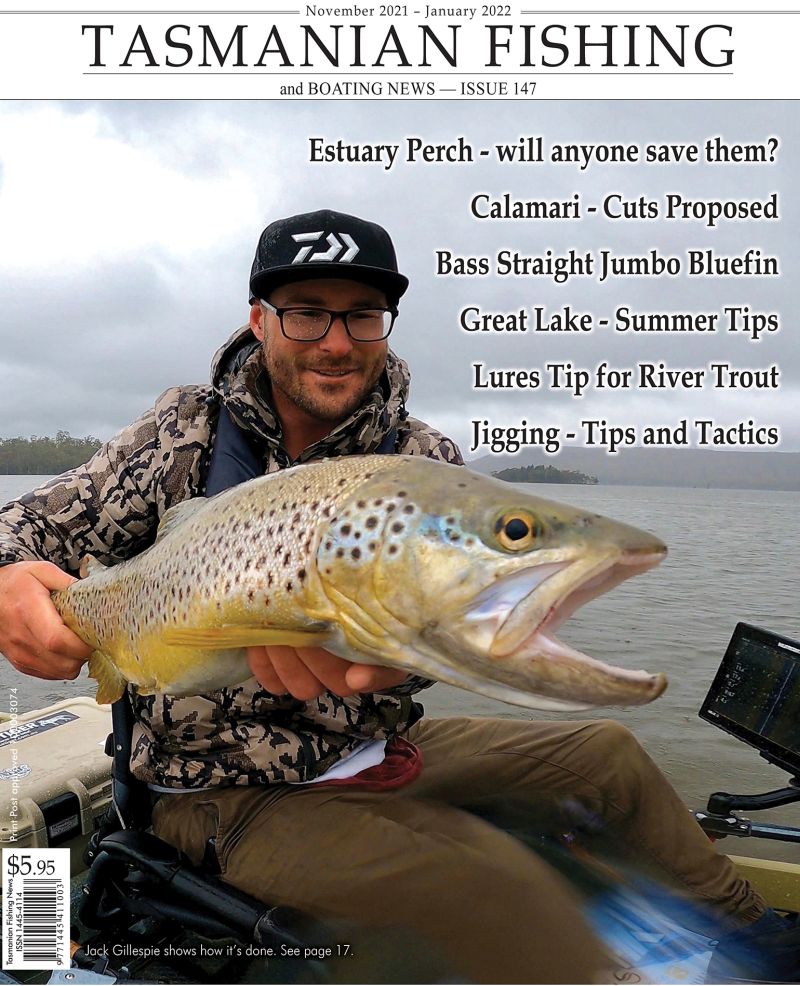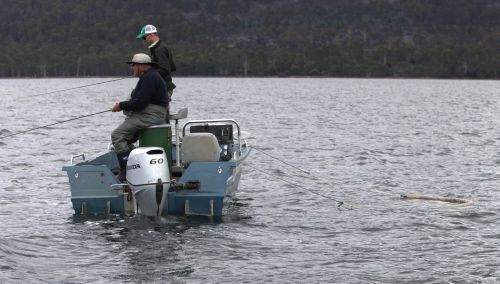From the Archives ...
Sea runners - Early Season Excitement - Christopher Bassano
Presented from Issue 100
Considering the world class quality of our sea trout fishery, these fish are not sought after by enough anglers. Sea runners live in the salt water and run up our estuaries and rivers from the start of August to the middle of November. At this time of the year, they are here to eat the many species of fish that are either running up the rivers to spawn or are living in and around the estuary systems. Trout, both sea run and resident (Slob Trout) feed heavily on these small fish which darken in colouration as they move further into fresh water reaches.
The majority of these predatory fish are brown trout with rainbows making up a very small percentage of the catch. They can be found all around the state but it would be fair to say that the east coast is the least prolific of all the areas. They still run up such rivers as the Georges (and many others) but their numbers along with the quality of the fishing elsewhere make it difficult to recommend the area above the larger northern, southern and western rivers.
Read more ...King George Whiting
There are a number of Whiting species found throughout Australia, and many Tasmanians would be surprised to learn that recreational fishing surveys report around 10,000 Whiting are caught in Tasmanian waters every year. These would mostly be sand whiting though.
The King George Whiting is the prize. It is the largest and most well renowned species and is considered one of the best table fish around.
Normally South Australia is spruiked as the KGW capital of Australia but in recent years Tasmanian waters have started to produce some regular numbers of good quality, well sized KGW.
- Written by Stephen Smith - Rubicon Web and Technology Training
- Category: Saltwater and Estuary Fishing
- Hits: 14269
Bream on Fly
Tasmanian Bream are a fantastic sports fish that offer the Tasmanian angler a challenging and rewarding day on the water. Black Bream, in Tasmanian waters, have been able to grow to impressive sizes due to the limited angling pressure they receive and the healthy estuary systems they live in. Bream up to 2.5 kg are not uncommon in our waters and these very old fish are often seen and caught amongst schools of bream in the upper tidal reaches of a river during the spawning season.
- Written by Stephen Smith - Rubicon Web and Technology Training
- Category: Bream
- Hits: 7499
Meet the Flatheads
How many Flathead are caught in Tassie? Flathead are the most commonly caught recreational species in Tasmania, accounting for almost two-thirds of all fish caught. Over 1.8 million flathead were caught by Tasmanian recreational fishers between December 2007 and November 2008. 1.07 million of these flathead were kept and 745 000 (around 40%) were released, showing an increasing trend toward fishers doing the right thing by releasing undersize fish.
Interesting Flattie Facts
- Written by Stephen Smith - Rubicon Web and Technology Training
- Category: Saltwater and Estuary Fishing
- Hits: 13037
More on whitebait - From 1961
An extract from the Inland Fisheries Commission Annual Report 1961. Introduction In 1941, commercial exploitation began of the whitebait, Loverria sealii (Johnston).earlier the whitebait had been valued by anglers, who considered that the entry of great quantities of these small fish into the estuaries of rivers on the North- West and Northern Coasts, particularly from August to October, both provided a bountiful source of food for trout (Salmo trutta) and induced the trout to come into areas where they became more available to anglers. Dr M Blackburn of the CSRIO Division of Fisheries, in reports supplied to the Fisheries Division of the Department of Agriculture in 1948 and again in 1949, described the biology was followed by a sharp and substantial decline. A report of Dr Blackburn’s investigations was published in 1950 (Aust. J Mar. Freshw. Res. 1:155-98). Representations by the North-Western Fisheries Association and the former Salmon and Freshwater Fisheries Commissioners south the prohibition of further commercial exploitation of whitebait in the north and were referred to the writer by the Hon. Minister of Agriculture and Fisheries.
The Fish
The published reports show that the whitebait enter from the sea in spring for the purpose of spawning near the upstream limits of tidal waters, the fish are one year old and about two inches long. From 100 to 200 eggs are laid and adhere to submerged logs, stones, &c. Few adults survive for long after spawning. Eggs hatch in about three weeks and the young drift out to sea. Dr Blackburn fund that the whitebait of the Northern rivers belonged to a common stock which should be treated as one for purposes of management. Similarly there was another common stock in the Southern rivers. The Northern fish, when taken, are of higher quality because they comprise mainly gravid and unpigmented fish. The Southern fish, as taken, comprise of a higher proportion of darker, spent fish.
Fishing Methods
Tidal reaches of the two main Southern rivers, the Huon and the Derwent, are so broad and deep that effective netting with permitted apparatus is difficult, expect above the areas where the main spawning presumably takes place. Most of the Northern whitebaiting rivers have steep gradients to near the coast and have very short tidal reaches. Fishing is permitted by licensees only and is at present restricted to the months of August to December. A licensee may use up to four scoop nets, being not more than 30 inches in diameter at the mouth, nor more than five feet in depth. Such scoops may be fished as dip nets in the margins or as set nets with mouths facing downstream in the assumed path of fish in deeper water. At the peak of fishing activity which occurred in 1947, over 900 scoops were in use on Northern Rivers. Many such rivers are small and leads followed by fish could be almost completely blocked by scoops. If the fish tend to “see-saw” with the tide, or to drop back and return again as rain affects stream levels, the same fish might hae to pass and repass successive batteries of nets. The impracticability of marking such small fish makes it impossible to determine the precise movements of fish after entry and the extent of the escapement during the season. The catches for successive months in 1960 showed that over a third of the total was taken in August, approaching half in September and that thereafter quantities fell rapidly and were only about 3% after October.
Value of the Fishery
At the peak of production in 1947, when the yield of Northern rivers was about 30 times as great as in recent years, the wholesale value of each catch was only £16,000. Canneries took much of the catch. The Tasmanian whitebait has never achieved the special fish delicacy value of the New Zealand whitebait, which fetches several times the price. (The New Zealand Commercial whitebait comprises mainly larval Galaxias attenuatus, a species which, although present in Tasmania, is not sufficiently abundant here to support a fishery). The recent retail price of Tasmanian whitebait has been about 2s. 6d. a pound. Whitebaiting is not a traditional fishery of the kind that has lead to the construction of jetties and other capital assets. A licensee can equip himself for a very small sum, although in paces a rowboat is also desirable. It is not like an ordinary fishery, where the necessity for a substantial capital outlay can condition the rate of expansion. With the whitebait fishery, any appreciable improvement in runs of fish could be followed within a week by a sharp increase in the number of persons equipped with licences and scoops. At its peak, whitebaiting provided direct part or full time seasonal employment for about 230 persons – a number which has declined to about 65. Except for a very few professional fisherman, who would apply themselves to whitebait or other species, according to abundance and ruling prices, the fishing is carried out largely as a spare-time occupation by amateurs having other means of livelihood, or by pensioners. At its former peak, the fiery is said to have had a disturbing effect on regular employment. It has never been dependable and sole source of livelihood. The average earnings of whitebaiters, even at the 1947 peak, were only about £70, earned over a season of several months. In 1960, wen the total catch was a little better than in any of the previous five years, individual fisherman still took on an average only a sixth the quantity they took in 1947.
Destruction of the Whitebait Fishery
Although commercial whitebaiting had commenced a little earlier in the South, there was only slight activity in the North before 1943. Then the number of licenses increased about four-fold from 1944 to 1947. The peak in total production in 1947, a year which there was a 38% increase over the 1946 catch, yet a drop in yield per scoop, or fishing unit of about 27%. Data published by Dr Blackburn for the 1943-1948 seasons have been amplified by further records made available by the Secretary of the Fisheries Division of the Department of Agriculture. The number of rivers fished rose from three in 1943 to seven in 1945 and a maximum of eleven in 1947. The Mersey and the Leven each contributed to about one third of the total catch. The 1960 the number of rivers fished had fallen to eight and in the Inglis, Cam and Blythe the catch was less than 150 lb. each. The Leven and Mersey produced over three-quarters of the total, the balance coming from the Duck, Black and Rubicon. The drop in catch per scoop from 1550 lb. in 1946 to 1130 lb. in 1947 might have been attributable to competition between the increased number of fishing units employed in restricted areas. However, no such explanation could account the catastrophic fall in 1948 of both gross yield and catch per unit. Dr Blackburn, in supplement to his 1948 report, proposed a total closure in 1949, to be followed by catch quotas of 100 tons in 1950 and 200 tons in 1951 with continuing observations to learn the most satisfactory permanent level. In consequence, there was no open season in 1949 and the Sea Fisheries Advisory Board decided to be advised by Dr Blackburn on a suitable duration for the 1950 season. Thereafter, regulations were drafted by providing for an open season from 15th August to 30th November, with machinery provisions for earlier closure to be ordered by Gazette notice, should the proposed quota be reached earlier. When the proposals became known, there was strong opposition from canners to the suggested quota of 100 tons. Following discussions between their representatives and the Sea Fisheries Advisory Board, it was decided the quota for 1950 should be 375 tons. Such a quota amounted to a greater quantity than had been taken in any earlier year except one and was actually 80% greater than the average annual catch f 209 tons for the years 1943-1948, which has caused the collapse of the fishery. A reservation that if “upon examination, any signs of depletion are indicated, the Minister will take action…to terminate the season” was meaningless, in view of the notification to the canners at the same time of this high quota. Obviously, if 375 tons had been taken, it would have proved an abundance of fish. But until such a quota was reached, the canners could argue that the run was late and they were holding cases, tinplate, labels &c., which they should be permitted to use. (The word “quota” was not in fact used in the notification to canners, which referred, not to a maximum, but “optimum” catch). In fact, no action was taken at all under the provisions for terminating the season, although in 1950 the catch fell to 10% of that of 1947 and when thereafter the deterioration continued until, in this last five years, the average annual yield has been 12 tons, that is, about one thirteenth of the proposed quota, the catch per unit in the last two years has averaged 130 lb. as against 440 in 1948 and 1550 in 1946. Since 1950, changes in regulations have ad the effect of making still more effective the destruction of the remnants of the Northern whitebait population. (For other reasons that whitebait conservation the Forth was closed to whitebaiting, but its earlier contribution had amounted to only 4% of the total yield). The 1950 regulations prohibited the taking of whitebait between sunset on Fridays and sunrise on Mondays. This reservation was dropped in the 1957 regulations. The earlier regulations prescribed a closed seasons from 1st December to 14th August. The 1957 regulations provided for an open season from 1st August until 1st January. The extension by four weeks at the end is unimportant, as the run is greatly reduced by the end of October, but the addition of a fortnight in August materially reduced the period within which uninterrupted spawning had previously been possible. In 1960, over a third of the total catch was taken in August and summaries of monthly catches indicate the probability of appreciable runs occurring in July. Probably this pre-season entry is all that saved the stock from extermination, or delayed such a happening.
Trout and Whitebait
If trout had never been established in the Northern rivers and coastal waters of Tasmania, there would still be adequate justification for a total cessation of whitebaiting for a number of years to learn whether it is not still possible for this species to re-establish itself in sufficient strength to permit carefully regulated exploitation at some future time. However, as was learnt in 1949, when whitebait were very greatly more abundant than now, closure for a single season is quite inadequate to permit recovery. Whatever influence the introduction of trout may have had on the whitebait population, the facts are that the two species co-existed with a considerable overlapping range for nearly 80 years and that predation by the trout was never severe enough to precent the whitebait continuing in very great abundance. Dr A G Nicholls, in a general consideration of size and abundance of trout in fresh and tidal portions of Northern rivers, between 1945 and 1954, (Aust. J. Mar. Freshw. Res. Vol 9, 1, 19-59) made no direct observations on the food of trout or special enquiry into inter-relationships of trout and whitebait. However, he remarks that he did not find any “direct, consistent correlation” between the estuarine trout fishery and the commercial whitebait fishery. It is important that this statement should not be misconstructed as a statement that the estuarine trout fishery was not in any appreciable measure influenced by the abundance of whitebait or the whitebait fishing practice. Direct and consistent correlations are unlikely to be demonstrated by the relatively scanty data, especially when there is only a partial environment overlap and the predator species is very catholic in its feeding habits. Indeed, Dr Nicholls has been careful to how the abundance of whitebait could affect the availability of trout to anglers by bringing them into effective rand of shore-based anglers. He also demonstrated that the number of days devoted to angling in tidal waters by the typical angler dropped by half as the whitebait stocks fell off. The finding that such anglers as did fish tidal waters took much the same quantity of fish as formerly is not inconsistent. While there is no positive evidence that it is so, it is a logical and widely held belief that trout, which are present in abundance in coastal waters, follow shoals of small anadromous fishes into rivers and that the duration of their stay in tidal reaches is much dependent on the continued availability there of such small fry. Whether this is correct or whether the presence of concentrations of whitebait in marginal waters simply induces local inshore movement of trout, which would normally be lying deeper and more widely dispersed in the estuaries, is it not really important. It is beyond reasonable dispute that the presence of whitebait does induce trout to feed both vigorously and conspicuously at inshore points where the small fry concentrate and that thereby trout become readily available to anglers. Such concentration points (usually eddies offering some shelter from strong currents) appeal equally to whitebaiters and to trout. As the angler seeks the actively feeding trout, he comes into direct positional conflict with the whitebaiter. In the restricted estuaries of the Northern rivers, each with its limited number of good concentration points, the actual disturbance or domination of areas by whitebaiters can make angling relatively ineffectual, or, at the very least, very unattractive. To the angler, the whitebaiter is a source of direct interference with his sport, while the whitebaiter, I turn, suffers the annoyance of having the smooth movement of whitebait frequently disturbed by the feeding trout. No one who has observed trout feeding on whitebait would need to have his observations reinforced by analysis of gut contents, before and after the commercial whitebait fishery developed, to be convinces that the substantial destruction of the whitebait population has been seriously damaging to the trout fishery.
Conclusions
1. An indigenous species of fish, the whitebait, which a few year back was enormously abundant, has so diminished in numbers that recent commercial yield has been about 6% of what it formerly was.
2. Trout and whitebait had co-existed for nearly 80 years and the whitebait continued to be extraordinarily abundant until commercial exploitation started.
3. There is irrefutable evidence that the whitebait fishery has been substantially destroyed by gross over-fishing, which has continued, with increasing ill effects, for a decade after competent scientific enquiry had diagnosed the cause of the first sharp decline and recommended remedial measures. There has for 10 years been failure to attempt to arrest or remedy the continuing decline by exercising powers provided for that purpose in regulations made in 1950. Instead, the earlier regulations have been relaxed further to permit more sustained fishing during the former open season and an extension of such season.
4. The destruction of the Northern whitebait population may already have proceeded beyond the point from which recovery might be possible. Only the immediate and complete cessation of all exploitation in Northern waters for some years would appear to offer any hope of saving the whitebait population.
5. An incidental effect on the substantial destruction of the whitebait population has been the loss of a valued trout food. Such food has been of special significance in that it greatly increased the availability of trout in estuarine waters, thereby making for better fishing and less congestion in inland waters.
6. Whitebait fishing in the Northern rivers is the part-time interest of 65 persons. Trout fishing in the same rivers is the part-time interest of over 6500 local North-West Coast residents.
Recommendations
1. It is recommended that regulation 33 (3) of the 1957 Sea Fisheries Regulations be invoked at once and that a Gazette notice be issued closing all the Northern rivers to whitebaiting in the season which otherwise would be open on 1st August next.
2. That in view f the failure of the single closed season in 1949, to permit recovery of the stock, which was then in a very greatly stronger position, closure for a number of years now be contemplated. DF Hobbs, Commissioner. 30th June, 1961.
- Written by Stephen Smith - Rubicon Web and Technology Training
- Category: Whitebait
- Hits: 4897
Sea Trout are a bit of an enigma around the world. Runs of these brown trout, born in a river, migrating to sea, and returning to a river for feeding (or spawning in autumn), are notoriously hard to predict. But like searching for Lasseters mythical reef of gold, the thrill of the chase and the promise of big rewards (sight-fishing to double figure fish if successful), offers more than enough attraction for most of us fly fishers! Timing is all about recent rainfalls (the time between the wet of spring and the dry of summer is when things peak), and the availability of migratory food sources such as whitebait are key to success.
- Written by Stephen Smith - Rubicon Web and Technology Training
- Category: Saltwater and Estuary Fishing
- Hits: 3406
Sea run trout tactics – Craig Vertigan
During the trout off-season I tend to spend a bit of time chasing bream, to continue getting a fishing fix, and spend time tying flies and dreaming about the trout season to come. It’s a time to spend doing tackle maintenance, stocking up on lures and dreaming up new challenges and goals for the trout season ahead. When the new season comes around I usually spend the first few months targeting sea runners. Sea run trout are simply brown trout that spend much of there lives out to sea and come in to the estuaries for spawning and to feed on whitebait and the other small endemic fishes that spawn in late winter through spring. Mixed in with the silvery sea runners you can also expect to catch resident fish that have the typical dark colours of a normal brown trout as well as atlantic salmon in some of our estuaries that are located near salmon farm pens. Living in Hobart it is quick and easy to do a trip on the Huon or Derwent and is a more comfortable proposition compared to a trip up to the highlands with snow and freezing winds to contend with.
- Written by Stephen Smith - Rubicon Web and Technology Training
- Category: Saltwater and Estuary Fishing
- Hits: 16966
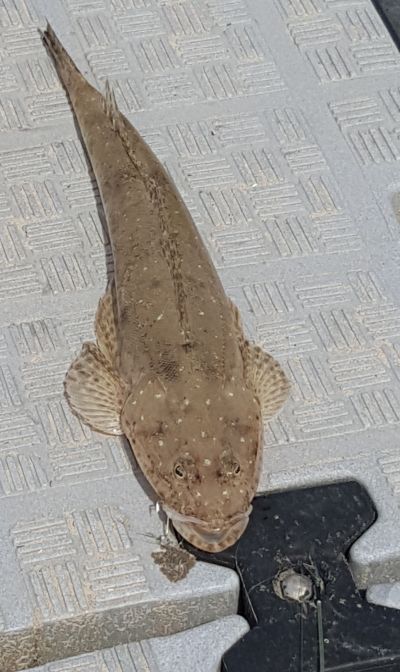 Wynyard Jetty Flathead
Wynyard Jetty Flathead
48cm long sand flathead caught off the end of pontoon at Wynyard yacht club boat ramp. 735 grams was it's weight.
Click "Read More" for a full sized picture
- Written by Stephen Smith - Rubicon Web and Technology Training
- Category: Saltwater and Estuary Fishing
- Hits: 10277
Marine Science Special Podcast
Deep sea climate change, enviro bags, over-fishing
It's a Marine Science Special! Professor Emma Johnson joins Dr Karl and Zan Rowe to help answer your ocean-based science questions.
http://www.abc.net.au/science/drkarl/scienceontriplej/
- Written by Stephen Smith - Rubicon Web and Technology Training
- Category: Saltwater and Estuary Fishing
- Hits: 5087
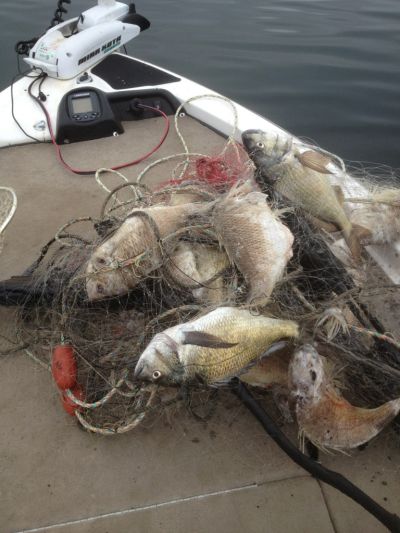 Should recreational nets be banned?
Should recreational nets be banned?
An opinion piece with Mike Stevens
Many Tasmanian fishermen remember how easy it was to catch a feed of fish back in the day. Parents cherished teaching their children how to fish and took pride in Tasmania’s fisheries. But things have changed, and our fisheries just aren’t what they used to be. Bag limits are tightening and size restrictions are getting stricter. Phasing out recreational gillnets need to be part of this effort to bring our fish back because they simply don’t allow the ‘limit your catch, don’t catch your limit’ approach required to look after our fish stocks in today’s times.
Fishing favourites Bastard Trumpeter, Blue Warehou and Banded Morwong, are all at historic lows and are vulnerable to gillnetting. Over one third of all fish caught using gillnets is thrown away – wasted. In the case of Banded Morwong and some sharks, around 90% are discarded. These are fish that need to be growing into breeders.
- Written by Stephen Smith - Rubicon Web and Technology Training
- Category: Saltwater and Estuary Fishing
- Hits: 5786
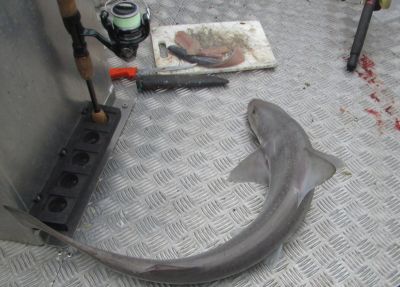 Low Head Report 14/6/2015
Low Head Report 14/6/2015
Despite the pretty cold and drab conditions I decided I'd go for a look off Low head yesterday[14/06/2015] for a Gummy and perhaps a few Flatties.I left Kelso ramp at 8.45am when at least it had warmed up a bit to be met by a sea that was devoid of swell and just some small wind waves.I went to a spot I fish fairly regularly and dropped the anchor in 18m of water. Usually I've got some burley but yesterday the freezer was empty.
- Written by Stephen Smith - Rubicon Web and Technology Training
- Category: Saltwater and Estuary Fishing
- Hits: 5824
Subcategories
Current TFBN
Click above for current issue content. The current issue of TFBN is extensive and topical. In Tackle Stores, Newsagents and by subscription.
Delivered to your door for $48 for 2 years (8 issues). To subscribe, send Mike $48 via www.paypal.com.au . (Basic instructions are here) The email is at Contact Us. Your address will be included from PayPal.
Or phone Mike with your c/c handy on 0418129949
Please ensure your details are correct, for Mike to organise delivery.
TFBN Newsletter Sign up Form
Why not submit an article ?
When you have finished for the day, why not have a brag about the ones that didn't get away! Send Mike an article on your fishing (Click here for contact details), and we'll get it published here. Have fun fishing - tasfish.com
Category Descriptions
Here is a list of all of the Article Categories. The number in Brackets, eg (13) is the number of articles. Click on Derwent River and all articles relating to the Derwent will be displayed in the central area.
Articles by Category
-
Rivers (3)
-
Saltwater and Estuary Fishing (149)
-
Kayak Fishing (34)
-
Lakes (1)
-
Great Lake (62)
-
Lake Leake (52)
-
Woods Lake (16)
-
Lake Augusta (11)
-
Huntsman Lake (13)
-
Lake Pedder and Gordon (10)
-
Lake Dulverton (5)
-
Lake Crescent (6)
-
Tooms Lake (10)
-
Lake Mackintosh (2)
-
Lake Barrington (5)
-
Little Lake (8)
-
Meadowbank Lake (5)
-
Lake King William (7)
-
Lake St Clair (2)
-
Western Lakes (12)
-
Arthurs Lake (35)
-
Lake Echo (7)
-
Four Springs (54)
-
Lake Sorell (7)
-
Lake Burbury (6)
-
Other Lakes (57)
-
Brushy Lagoon (18)
-
Little Pine Lagoon (5)
-
Penstock Lagoon (16)
-
Brumbys Creek (7)
-
-
Events (48)
-
Estuary Fishing (0)
-
Coastal Catches (46)
-
Super Trawler (46)
-
IFS, DPIPWE, MAST and Peak Bodies (435)
-
Commercial Interests (98)
-
Other (24)
-
TFBN Back Issues (8)
-
Fly Fishing (67)
-
Trout Fishing (250)
-
Meteorology and Weather (8)
-
Jan’s Flies (50)
-
Tuna Fishing and other Game Fishing (86)
-
Cooking Fish (19)
-
Fishing Information (1)
-
Fishing Books (8)
-
Videos (5)
-
Tackle, Boats and other Equipment (146)
-
World Fly Fishing Championship 2019 (2)
Popular Tags
windyty.com
Visit https://www.windyty.com/
Rubicon Web and Technology Training
Hello everyone, I thought it would be a good time to introduce myself.
My name is Stephen Smith and I have been managing the website tasfish.com since May 2009.
It has been an epic journey of learning and discovery and I am indebted to Mike Stevens for his help, support and patience.
I am developing a new venture Rubicon Web and Technology Training ( www.rwtt.com.au ). The focus is two part, to develop websites for individuals and small business and to train people to effectively use technology in their everyday lives.
Please contact me via www.rwtt.com.au/contact-me/ for further information - Stephen Smith.
From the Archives ... (last chance)
Fishing on the Wild Side
Fishing on the Wild Side
Mike Fry doesn’t only live on the Wild Side of Tasmania, but also goes fishing in probably the wildest boat ever to troll for trout—certainly in Tasmania.
When your mate says ‘What are you doing tomorrow, want to come up the Gordon for the night?’ it would be pretty hard to say anything else except “you bet” and start checking out your tackle box and packing your overnight bag. But if your mate was Troy Grining and he wanted to give his new 52ft, high speed cruiser a run across Macquarie Harbour, test the new onboard dory with a chance of landing a nice Gordon River Brown you would have to feel privileged. I didn’t say anything about getting on my hands and knees and kissing his feet…just having a lend of ya’ but I did feel very appreciative.

